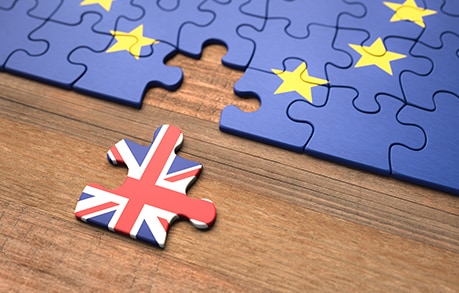
With the ultimate outcome of Brexit as unsettled as ever, the British pound has retested its 2016-17 lows versus the dollar and euro. If the UK crashes out of the European Union (EU) without a deal, the pound could potentially fall much further. By contrast, should the UK leave with a deal, the pound could soar. How much should investors and consumers worry about the direction of the currency?
To answer that question, we built a regression model of month-on-month changes in UK consumer prices (using the UK EU Harmonized CPI Core Index), factoring for seasonal variations, movements in petrol prices, change in the value-added tax, and rise and fall in the trade-weighted value of the pound.
Here’s what we found:
- A 10% rise/fall in the trade-weighted pound will correspond to a 1% rise/fall in the rate of inflation, beginning about four months after the movement in currency takes place.
- A 1% increase/decrease in the value-added tax will cause prices to rise/fall by about 0.5%, with about half of the impact being felt in the first month, and most of the rest being absorbed in the subsequent 2-3 months.
- A 10% rise in oil prices will lead to about a 0.5% rise in consumer prices, excluding energy, with the price rise beginning about 1-2 months after the movement in petrol prices as higher petrol prices drives up transportation costs, the price of plastics and packaging etc.
If the UK strikes a deal with the EU and the pound returns to its pre-referendum levels of three years ago, the currency would rise 16% against its trade-weighted basket of currencies. According to our model, that could lower UK inflation by around 2% beginning about three or four months after the movement in the currency. That could take inflation towards zero. By contrast, if the UK crashes out without a deal, it’s easy to imagine the currency falling a further 10% since a no-deal outcome has not been fully priced by the market (Figure 1). In that event, inflation could rise from the current 1.9% pace towards 3%. The good news is that either way, the impact on inflation would most likely be temporary and would play out over the course of about one year and the rise in prices wouldn’t be noticeable for the first three months or so after the currency moves.
While our model suggests that a no-deal outcome would only produce a temporary rise in inflation, it is possible that the rise in inflation could become more entrenched in the resulting trade barriers, create persistent inefficiencies in the production and distribution of goods, and lower productivity growth.
Our findings, based on monthly data from 1994 to 2019, are broadly consistent with the experience of the past few decades (Figure 2):
- The trade-weighted pound soared 30% between late 1996 and early 1998. Core inflation fell from 2.2% in late 1996 to -0.1% in early 2000.
- The trade-weighted pound crashed 30% between July 2007 and November 2008. Core inflation rose from around 1.2% in early 2008 to as high as 3.7% in early 2011 despite soaring unemployment and a fall in oil prices.
- From March 2013 to July 2015, the trade-weighted pound rose nearly 22% and core inflation fell 2.3% to 0.8%.
- Between late 2015 and October 2016 the pound fell 22% – most of it coming in the days after the referendum result become known. Core inflation rose from 0.8% to 2.7%.
In 2017, UK imports totaled 23.5% of GDP. So, with a beta coefficient on currency movements close to – 0.1, this is broadly consistent with the idea that half of the eventual costs (or benefits) of currency movements will eventually be passed on to UK consumers. The remaining half appears to be absorbed by suppliers and retailers. We would note, however, that when the pound falls, price increases tend to get passed on to UK consumers more quickly than price decreases when the pound strengthens. Retailers appear to lock in prices for their goods about three months in advance, so in the short term, currency movements have little, if any, impact on prices.
Finally, the level of unemployment appears to exert no influence on the level of inflation at all – at least not that we were able to discern, suggesting that the Phillips Curve, representing the inverse relationship between inflation and unemployment, in the UK is just as flat as it is in the US and in most of Northern Europe. If the notion that inflation has become disconnected from unemployment is correct, the Bank of England (BOE) has little to worry about from keeping policy easy in either the case of a difficult Brexit with a further sell off in the pound and a temporary boost to inflation or a smooth end to the Brexit saga, a pound rally and a temporary dip in inflation. That could change, however, if Brexit creates lasting inefficiencies and causes wage growth to outstrip productivity growth.
Read original article: https://cattlemensharrison.com/the-disinflationary-implications-of-brexit/
By: CME Group
